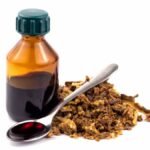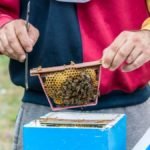An inner cover is an optional part of a Langstroth beehive. There are certain management strategies where this cover is useful, and there are other times when it is a hindrance. Beehive inner cover plans are available on the net but they often ignore the important ways you can save money making these covers. It is relatively inexpensive just to buy a cover, but if you want to make one, there is a certain satisfaction that comes from recycling wastes and doing your bit for the environment! You definitely won’t save money making the cover, but at least you save the planet.
What Does The Inner Cover Do?
The standard inner cover for a Langstroth hive consists of a board of some sort with a frame around it that observes bee space. There is a handhold/ventilation space normally in the middle of the cover. The lid normally fits over this cover. In some beekeeping systems, this cover is really important, and in other systems, it is a hindrance.
I tend to feel that an inner cover is a very useful thing if you intend to have bees that stay in one place. If you are into migratory beekeeping, an inner cover is a pain in the neck and there are far better options for covering your hive.
In my opinion, they provide a place for hive beetles to be a nuisance.
Do We Really Need An Inner Cover?
When considering the amount of work involved in following beehive inner cover plans and then making the things, my answer is “Mostly no.” There are times when these covers can be useful, but in my opinion, they are probably the least useful part of a beehive. I like using the so-called Australian migratory lids. These lids consist of a solid plywood top with a two-inch frame around it. Normally we attach a metal sheet to the top of this to protect it, and then it provides the bees with a 2-inch cluster space over the top frames of the supers.
The lovely thing about Australian Migratory lids is that in a heavy honey flow the space in the lid fills up with the most delicious comb honey!! You will get a few pounds of delightful white honeycomb that gets packed into the lid gap. The rest of the time it just provides the bees with excellent ventilation space and cluster space at night.
A big advantage of an inner cover is that if the actual lid blows off these covers normally stay on and will protect the bees enough that they will not normally abscond. The bees will just propolize the handhold in the middle shut. When naughty kids/teenage hooligans/bears/baboons/drunk people and other problem animals find apiaries the lids of hives normally can get removed before the bees educate the offending creatures.
Ok, I Still Want An Inner Cover – How Do I Make One?
The easiest way to make an inner cover is to purchase a Masonite board. This is an engineered high-density fiberboard. I personally hardly ever bought this stuff – I would just go around after elections and collect the backing boards that political parties use to stick their posters on poles around town. If you do not have this sort of election happening, you can always visit a brewery, where these boards are often used to separate bottles on pallets. You can normally “buy” these from people at the brewery for a bottle of honey or two. If you do need to buy the board and hardware store will have these sheets typically in a 4’x8′ sheet.
You can find a nice step-by-step guide on how to make these here together with beehive inner cover plans.
Should I Paint The Inner Cover Of The Beehive?
No – if the board is made from Masonite or a similar type of HDF it will easily outlast you if you look after it. When it comes to beehive inner cover plans, you will see no call for painting in any guide. Painting hives on the inside is never a good thing.
Paint may be marked as lead-free, but this does not mean that it is free of all toxic things. Paint is something that flakes with time, and the last thing you want is some flake of paint ending up in your honey, propolis, or wax. The bees will rapidly coat the inner cover with propolis and wax in a few years, and after this, the cover is pretty much indestructible.
Should I Use An Inner Cover With A Hive Top Feeder?
Generally, the inner cover will get in the way – this will depend on which type of hive top feeder. You can use a Candy board with a feeder such as this in winter. Generally, the candy board is supposed to be a replacement for an inner cover, but some beekeepers find that placing an inner cover on top of the candy board improves winter survival.
These feeders are far less problematic in a hive than hive top feeders and if you are using inner covers, you can continue as per normal with these.

Beehive Inner Cover Plans – The Simplest Route
One really simple option for an inner cover is to just cut a sheet of fabric!! You can even buy them precut here. I find these work really well – I used to use an old 2 WW military tent that got destroyed by a wild animal. We used sections of this tent for years and it worked beautifully. The bees propolize the canvas to the top of the frames and leave little crawl holes for themselves. This seems to insulate them well.
You can remove the covers and roll them up. Place the rolled covers in the freezer and then once the propolis freezes unroll them in a basin. The propolis will flake off and collect in the basin. This allows you to use the inner cover to harvest propolis. As far as beehive inner cover plans go, this one is a gem! It works and helps you make medicine.
I hope this article has helped you with your beehive inner cover plans. You can see there are many options, and it is important to test these and see what works for you. If you enjoyed this article please share!
Bee Hive Inner Cover FAQs
What is the purpose of a beehive inner cover?
The inner cover provides insulation and ventilation for the hive while preventing the bees from attaching comb to the hive lid. It also helps control moisture buildup and adds a layer of protection when the outer lid is removed.
Is it necessary to use an inner cover in all beehives?
No, not all beekeepers use inner covers. It’s particularly helpful for stationary hives, but for migratory beekeeping or certain management strategies, some prefer to omit it in favor of simpler options like migratory lids.
What materials can be used to make a beehive inner cover?
Common materials include Masonite or high-density fiberboard (HDF). Recycled materials like election posters or brewery pallets can also be used, offering an eco-friendly option for creating a DIY inner cover.
Should I paint the hive inner cover?
No, it’s not recommended to paint the inner cover. Bees will coat it with propolis over time, which preserves it naturally. Additionally, paint flakes can pose a contamination risk for the hive.
How do I make a simple inner cover for my beehive?
The simplest method is to cut a piece of Masonite or even use fabric like canvas, which bees will propolize. Pre-made covers can be found online, or you can craft one yourself using step-by-step plans readily available.
Can I use an inner cover with a hive top feeder?
It depends on the feeder type. Some hive top feeders may interfere with the inner cover, but alternatives like candy boards are designed to work with or replace inner covers, particularly during the winter.
What are the benefits of using a fabric inner cover?
Fabric inner covers are lightweight, easy to clean, and can double as a tool for harvesting propolis. The bees will propolize the fabric, and it can be rolled up and frozen to collect propolis flakes for medicinal uses.
Can an inner cover help protect my hive from pests?
While an inner cover provides ventilation and insulation, it can also attract pests like hive beetles. Some beekeepers prefer migratory lids or other alternatives to reduce pest issues.

Dr. Garth A. Cambray is a Canadian/South African entrepreneur and beekeeper with 28 years of experience in apiculture and specializes in adding value to honey. His Ph.D. research developed a new advanced continuous fermentation method for making mead that has resulted in a number of companies globally being able to access markets for mead. His company, Makana Meadery, exports honey mead to the USA where it is available to discerning connoisseurs. He has also developed technologies to commercially manufacture organic honey vinegar in Zambia for export globally. He holds a few patents globally in the ethanol industry and believes in technology and knowledge transfer for human development and environmental sustainability. One of his proudest achievements is the fact that the wind farm he started at one of his old apiary sites has essentially made his hometown carbon neutral.






